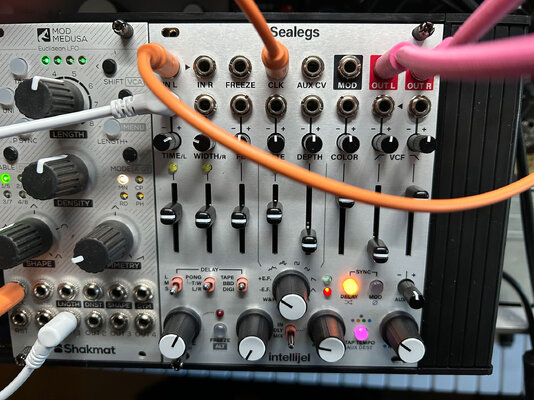Absolut Geiles Delay mit Fadern , zig Modis , einen FOG (Reverb) dass im Gegenteil zum Halo FX im Mimeophon nicht fest verdrahtet ist.

 schneidersladen.de
schneidersladen.de
Intellijel Sealegs ist ein organisches, musikalisches Delay, das drei Delay-Ansätze mit viel Liebe zum Detail modelliert und mit intuitiver Bedienbarkeit verbindet.
Ein Delay lebt von seiner Lebendigkeit. Unspezifische, kleine Fehler so nachzubilden, dass man sich an legendäre Delaymachines aus goldenen musikalischen Zeiten erinnert, ist sicherlich eine Königsdisziplin bei der Effektentwicklung.
Mit Sealegs (dt. "Seemannsgang") hat Intellijel sich dieser Herausforderung angenommen und ein Multi-Model Stereo Character Delay entwickelt, das obendrein auch noch ein Reverb besitzt. Dabei wurden drei Modelle von Verzögerungsansätzen, Tape Delay, Bucket Brigade Delay (BBD) und ein Crossfading Digital Delay präzise nachgebildet, sodass sich die modellspezifischen Klangfarben nebst Modulationseigenschaften und Sättigungsverhalten einstellen.
Eine große Anzahl von Reglern erlauben einen detaillierten Klangeingriff, so dass man als Klangkapitän an Deck seines Soundschiffes nicht ins Rutschen gerät. Damit lassen sich z.B. für den linken und rechten Kanal voneinander unabhängige Delayzeiten einstellen, die wahlweise synchronisiert oder unsynchronisiert sind. Ein eingebauter Modulator bringt mit seinen sieben Morphing-Wellenformen Leben an Bord, während die Wow- und Flutteremulation für den "Wobble"-Faktor zuständig ist. Daneben gibt es Input Drive, Envelope Follower, dedizierte Low-Highpassfiler für die Delayfahne, zumischbare Noise- und Knistergeräusche, (Klang-)Färbung des Delaysignals, ein 70s-inspiriertes Reverb sowie rekonfigurierbaren Signalfluss durch das in 96KHz, 32 Bit Stereo-Fließkomma-Verarbeitung betriebene Modul.
Für die Hauptparameter wie Time, Feedback, Rate, Depth stehen 9 Fader mit CV-Input und Attenuverter zur Verfügung. Mittels weiterer 9 Audio and CV-In bzw. Outputs, Sync-/Tap-Optionen und Freeze-/Looping-Funktion der Delayfahne kann das Spiel zwischen Ebbe und Flut in eurem Modularsystemen beginnen.
Features:

Intellijel Designs - Sealegs
Ein Delay lebt von seiner Lebendigkeit. Unspezifische, kleine Fehler so nachzubilden, dass man sich an legendäre Delaymachines aus goldenen musikalischen Zeiten erinnert, ist sicherlich eine Königsdisziplin bei der...
€465,00
Intellijel Sealegs ist ein organisches, musikalisches Delay, das drei Delay-Ansätze mit viel Liebe zum Detail modelliert und mit intuitiver Bedienbarkeit verbindet.
Ein Delay lebt von seiner Lebendigkeit. Unspezifische, kleine Fehler so nachzubilden, dass man sich an legendäre Delaymachines aus goldenen musikalischen Zeiten erinnert, ist sicherlich eine Königsdisziplin bei der Effektentwicklung.
Mit Sealegs (dt. "Seemannsgang") hat Intellijel sich dieser Herausforderung angenommen und ein Multi-Model Stereo Character Delay entwickelt, das obendrein auch noch ein Reverb besitzt. Dabei wurden drei Modelle von Verzögerungsansätzen, Tape Delay, Bucket Brigade Delay (BBD) und ein Crossfading Digital Delay präzise nachgebildet, sodass sich die modellspezifischen Klangfarben nebst Modulationseigenschaften und Sättigungsverhalten einstellen.
Eine große Anzahl von Reglern erlauben einen detaillierten Klangeingriff, so dass man als Klangkapitän an Deck seines Soundschiffes nicht ins Rutschen gerät. Damit lassen sich z.B. für den linken und rechten Kanal voneinander unabhängige Delayzeiten einstellen, die wahlweise synchronisiert oder unsynchronisiert sind. Ein eingebauter Modulator bringt mit seinen sieben Morphing-Wellenformen Leben an Bord, während die Wow- und Flutteremulation für den "Wobble"-Faktor zuständig ist. Daneben gibt es Input Drive, Envelope Follower, dedizierte Low-Highpassfiler für die Delayfahne, zumischbare Noise- und Knistergeräusche, (Klang-)Färbung des Delaysignals, ein 70s-inspiriertes Reverb sowie rekonfigurierbaren Signalfluss durch das in 96KHz, 32 Bit Stereo-Fließkomma-Verarbeitung betriebene Modul.
Für die Hauptparameter wie Time, Feedback, Rate, Depth stehen 9 Fader mit CV-Input und Attenuverter zur Verfügung. Mittels weiterer 9 Audio and CV-In bzw. Outputs, Sync-/Tap-Optionen und Freeze-/Looping-Funktion der Delayfahne kann das Spiel zwischen Ebbe und Flut in eurem Modularsystemen beginnen.
Features:
- Drei legendäre Delay-Modelle (Tape, BBD, Digital) mit modellspezifischer Koloration, Modulationsverhalten und Sättigung/Limiting
- Drei Stereo-Konfigurationen (PONG, L/R, Time/Width)
- Eingebauter Modulator mit sieben Morphing-Wellenformen
- 70s-inspirierter Hall ("Lush")
- Zumischbares Rauschen und Knistern
- High- und Lowpassfilter zum Sounddesign der Delayfahne
- Input Drive mit Pegelanpassung
- Freeze-Funktion: Freezing und Looping des Delay-Speichers für jedes Modell
- Delay-Zeiten bis zu 6 Sekunden (Linker Kanal) und 8 Sekunden (Rechter Kanal, Width addiert 33% zur Delayzeit)
- 9 CV-Eingänge (mit Attenuvertern)
- Stabiles externe Clock-Syncing (oder Tap-Tempo)
- 96 kHz, 32-Bit-Stereo-Fließkomma-Verarbeitung
Zuletzt bearbeitet:

